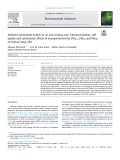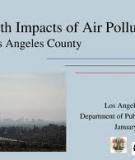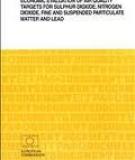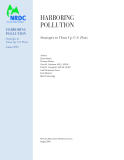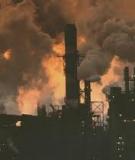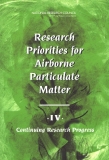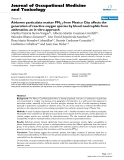
Airborne particulate matter
-
Ebook "Medical geochemistry: Geological materials and health" includes a collection of chapters illustrating the application of geochemical methods to investigate the interactions between geological materials and fluids with humans. Examples include the incorporation and human health effects of inhaling lithogenic materials, the reactivity of biological fluids with geological materials, and the impact on nascent biomineral formation.
 199p
199p  duongthandue0501
duongthandue0501
 28-02-2024
28-02-2024
 2
2
 1
1
 Download
Download
-
While the physical and chemical properties of airborne particulate matter (PM) have been extensively studied, their associated microbiome remains largely unexplored. Here, we performed a longitudinal metagenomic survey of 106 samples of airborne PM2.5 and PM10 in Beijing over a period of 6 months in 2012 and 2013, including those from several historically severe smog events.
 11p
11p  viarchimedes
viarchimedes
 26-01-2022
26-01-2022
 8
8
 0
0
 Download
Download
-
The results demonstrate that the PM10 mass collected were higher than those reported by the local governmental agencies and the PMs are mainly constituted by hematite and quartz. EDS analysis showed the presence of Fe, Si, Mg, Al, Zi, Ca, and emerging metallic contaminants, such as Ba and Ti, in environmental samples.
 15p
15p  thebadguys
thebadguys
 15-01-2022
15-01-2022
 19
19
 0
0
 Download
Download
-
Primary pollutants are those in which the substance emitted is itself hazardous. Some primary pollutants also produce other dangerous substances after undergoing chemical reactions in the atmosphere, and these are known as secondary pollutants. Primary pollutants include the following substances. Particulates This includes dust, smoke, aerosols and haze - any finely divided airborne solid material.
 13p
13p  doipassword
doipassword
 01-02-2013
01-02-2013
 45
45
 3
3
 Download
Download
-
Airborne suspended particulate matter (PM) can be either primary or secondary in nature. Primary particles are emitted directly into the atmosphere either by natural or anthropogenic processes, whereas secondary particles have a predominantly man made origin and are formed in the atmosphere from the oxidation and subsequent reactions of sulphur dioxide, nitrogen oxides and VOCs.
 85p
85p  saimatkhauroi
saimatkhauroi
 01-02-2013
01-02-2013
 53
53
 5
5
 Download
Download
-
After its emission or secondary formation, the length of time airborne matter will remain suspended in the air will depend upon its density, shape and size and meteorological conditions. Suspended particles are deposited by dry deposition, either by sedimentation and gravitational settling or impaction due to atmospheric turbulence and diffusion. This latter process is characteristic of particles which undergo Brownian movement and sizes below 0.1µm.
 318p
318p  saimatkhauroi
saimatkhauroi
 01-02-2013
01-02-2013
 52
52
 6
6
 Download
Download
-
A source of airborne particulate matter that cannot be neglected is the injection of windblown natural dust into the atmosphere in sand and dust storms common during windy conditions in the world’s deserts. In the northwestern Mediterranean region, the input of Saharan material, known locally as red rains, has been estimated as 3.9 million of tonnes each year [22]. In some parts of the Mediterranean basin, it is thought that this makes a substantial contribution to local airborne particulate matter.
 0p
0p  saimatkhauroi
saimatkhauroi
 01-02-2013
01-02-2013
 46
46
 4
4
 Download
Download
-
Both direct emission from fires and ash resuspension from burnt soils could be an important source of airborne PM10. This pyrogenic material, which is composed of organic matter, black carbon and inorganic material, is to a large extent present in the size range below 10 µm and so can be resuspended by wind [17]. Although the contribution to ambient aerosol from fire smoke will generally be episodic, in areas where there is a constant forest burning, the particulate emission from this source could be significant.
 35p
35p  saimatkhauroi
saimatkhauroi
 01-02-2013
01-02-2013
 58
58
 4
4
 Download
Download
-
Particulate emissions from road transport arise as direct emissions from vehicle exhausts, tyre and brake wear and resuspension of road dust. In urban areas, emissions from road transport are thought to be the major source of PM10. In general, diesel engine vehicles emit a greater mass of fine particulate matter, per vehicle, than petrol engines. Diesel emissions are mainly composed of soot particles, volatile hydrocarbons and some sulphate from the fuel sulphur.
 0p
0p  saimatkhauroi
saimatkhauroi
 01-02-2013
01-02-2013
 37
37
 3
3
 Download
Download
-
Airborne suspended particulate matter can be of primary origin, i.e. emitted directly into the atmosphere or of secondary origin, i.e. formed in the atmosphere from gaseous species by either homogeneous or heterogeneous chemical reactions. Due to these different emission sources, particles have different chemical composition and size distributions. Depending on their size, particles have a different potential to be transported over either long or short distances [1]. Primary particles can be produced from either natural or anthropogenic sources.
 342p
342p  saimatkhauroi
saimatkhauroi
 01-02-2013
01-02-2013
 54
54
 8
8
 Download
Download
-
Under the Clean Air Act, particulate matter (PM) is one of the major air pollutants for which National Ambient Air Quality Standards (NAAQS) are to be established on the basis of the scientific evidence on risks to human health. The U.S. Environmental Protection Agency (EPA), other federal and state government agencies, and nongovernment organizations are conducting a major multiyear research effort to improve scientific understanding of airborne PM and its effects on human health.
 373p
373p  mnemosyne75
mnemosyne75
 02-02-2013
02-02-2013
 45
45
 8
8
 Download
Download
-
Tuyển tập các báo cáo nghiên cứu về hóa học được đăng trên tạp chí sinh học quốc tế đề tài : Airborne particulate matter PM2.5 from Mexico City affects the generation of reactive oxygen species by blood neutrophils from asthmatics: an in vitro approach
 11p
11p  panasonic10
panasonic10
 13-01-2012
13-01-2012
 53
53
 3
3
 Download
Download
CHỦ ĐỀ BẠN MUỐN TÌM











